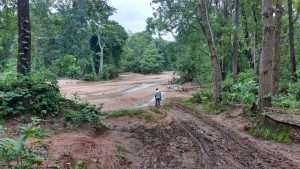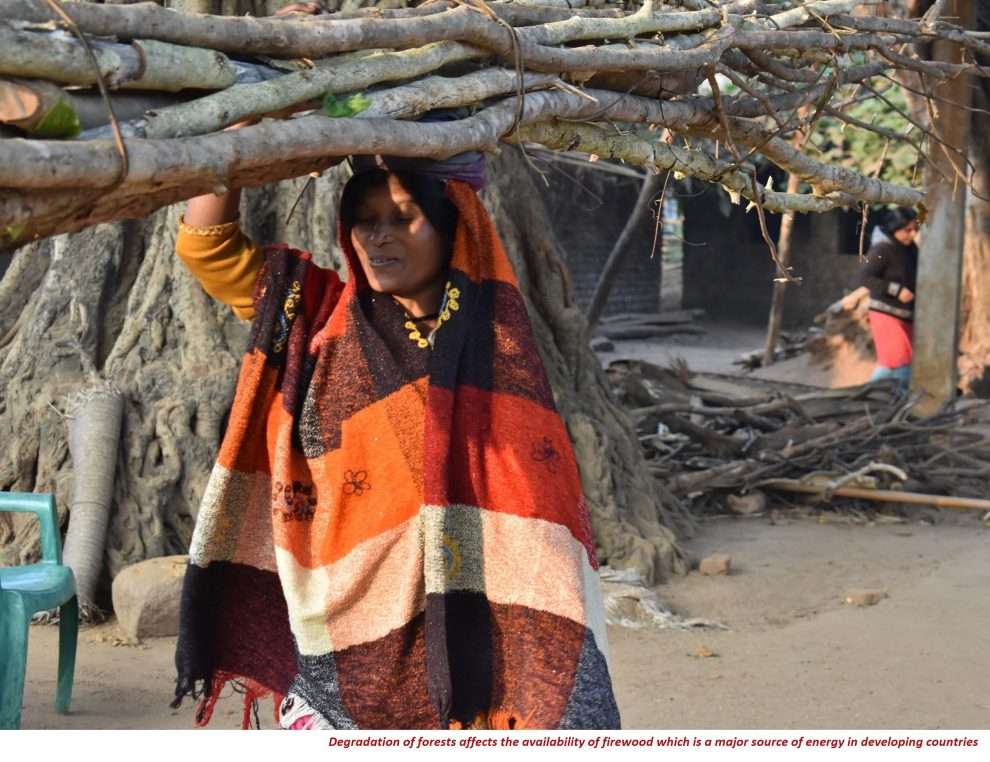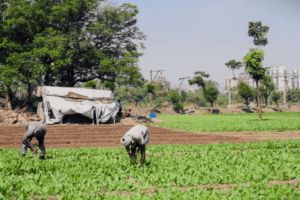In the backdrop of World Forestry Day (21 March 2022), Sandip Chowdhury argues for improved coordination for a cross-sectoral approach in better management of forest ecosystem services, and highlights the importance of strengthening Extension and Advisory Services (EAS) in the forestry sector.
CONTEXT
Ecosystem services are the benefits that people derive from natural ecosystems. A forest ecosystem provides multiple ecosystem services (food, water, energy, biodiversity, nutrient-cycling, climate regulation, etc.) that makes life on Earth possible. Forests are not just about trees and animals. These are complex socio-biological systems that cross-cut multiple disciplines. Since land is involved, it is very much a political issue too. This complexity, and the range of ecosystem services that it provides to diverse stakeholders necessitates the adoption of a cross-sectoral approach for its management.
WHY WE NEED A CROSS SECTORAL APPROACH
The need for a cross-sectoral approach – in both policy and implementation – is not a novel idea. We now know that there is a strong nexus between forests, agriculture, water, energy, livelihoods and climate. Almost every stakeholder consultation on issues around forest conservation points out how different stakeholders need to come out of their silos and interoperate more. However, when it comes to implementation, the movers and shakers of this field fall far short. A glaring example of this divergence between commitment and implementation is the Aichi Biodiversity Targets where we could not fully achieve even one of the 20 targets in 10 years with hardly any progress on ecosystem services (target no. 14 under Benefits).
India already has a robust and scientific management system to govern and manage its forest ecosystem services. Under the aegis of the Ministry of Environment, Forest and Climate Change (MoEFCC), the Indian Forest Department has largely been able to preserve the country’s remaining forests from ever increasing anthropogenic pressures. Although deforestation in India is nowhere near the scales seen in the tropical forests of Amazon, Congo or South-East Asia, biodiversity loss and forest degradation still continue to be the major challenges in our country. The fact that millions of forest dwelling and forest fringe communities in India depend on nearby forests for their livelihood and identity, makes the case for conservation and sustainable management of FES even more compelling.
 Forests help control the water cycle by regulating precipitation, evaporation and flows
Forests help control the water cycle by regulating precipitation, evaporation and flows
Towards polycentric governance
If conservation and sustainable FES management is to be a success in India, it is imperative that we adopt an informed, equitable and participatory management system. This kind of polycentric governance system allows for a seamless flow of information, collaborative planning and implementation among all societal actors, including those who don’t generally cooperate. All stakeholders have individual, complementary and nested roles to play in bringing about cross-sectoral and landscape level FES management with immediate and long term impact. For example, sustaining ecological flows in forest-fed rivers in the context of climate change, mounting demand for water, and increased forest degradation will involve cross-sectoral and sector-specific interventions. Some of the interventions, inter alia, might be restoration of catchment area (Forest Department), more water recharge structures (Department of Water Resources & Mahatma Gandhi National Rural Employment Guarantee Act [MGNREGA]), increasing water-use efficiency (Department of Agriculture), reducing water pollution (State Pollution Control Board and private sector), greater awareness (NGO), scientific inputs and geospatial monitoring and analysis (academia).
But how do we keep different stakeholders both engaged and motivated for a long time? One of the ways in which such a coalition can be maintained is through a multi-year campaign with each stakeholder’s roles and responsibilities institutionalized in their respective work plans. Unless all actors are bound by a common movement with sector-specific responsibilities and accountability, the project will always be at the risk of frittering away its time. One place to look for inspiration is the Let’s Millet campaign in Karnataka which aims to mainstream forgotten traditional foods, such as millet, in the state. The campaign involves the state’s agriculture department, agro-companies, online retailers, farmers, media, and the general public, and this has been able to raise the demand for organically grown millets in Karnataka. Sustainable FES management too will require a state-sponsored campaign for the public, involving cross-sectoral actors who act in mission mode. The table below outlines the implementation roles of such a cross-sectoral task force with regard to FES. The list is only indicative, and many more tasks can be added to make it more comprehensive.
Table1. Implementation roles of a cross-sectoral task force for FES
| Stakeholders/Actors | Roles and Responsibilities |
| Central Government |
|
| State Government |
|
| Forest Department |
|
| Line Departments (agriculture, horticulture, water resources, rural development, etc.) |
|
| Local Communities |
|
| Private Sector |
|
| Financial Institutions (especially NABARD) |
|
| Scientific and Educational Institutions |
|
| Transnational Think tanks/Multilateral agencies |
|
| NGOs/Civil Society |
|
| Media |
|
| Public |
|
Coordination
Knowledge-based cooperation and innovation that harnesses such cross-sectoral expertise and ingenuity can generate new possibilities and opportunities for the sustainable management of FES. However, these sector-specific actions need to be coordinated by a leading entity. Since the project is essentially about forest management, a state forest department is best suited to champion this project and anchor all the coalition processes. It also can take the assistance of community-level organizations, such as Joint Forest Management Committees (JFMCs), a corporate arm in the form of Forest Development Corporation, scientific and management advisory bodies such as Forest Research Institute (FRI), Indian Institute of Forest Management (IIFM), as well as several partnerships with multilateral agencies such as the United Nations (UN), World Bank, The Economics of Ecosystems and Biodiversity (TEEB), among many others. However, the Department of Forests is known for its bureaucracy and it has to be more accommodative in decision making and more responsive to innovations, feedback and change. Cross-sectoral implementation demands clarity of thought, mutual trust, and a sense of fairness among all actors. For such a model to succeed and be up-scaled, it is necessary that the approach and implementation is inclusive, integrated and executable.
 The United Nations General Assembly proclaimed 21 March the International Day of Forests (IDF) in 2012. The Day celebrates and raises awareness of the importance of all types of forests.
The United Nations General Assembly proclaimed 21 March the International Day of Forests (IDF) in 2012. The Day celebrates and raises awareness of the importance of all types of forests.
ROLE OF EXTENSION AND ADVISORY SERVICES
One of the starting points to galvanise this cross-sectoral mission should be the strengthening and expansion of the role of EAS providers vis-à-vis FES. Government institutions, NGOs, and even the private sector can play an important role in identifying current knowledge gaps and training both public and government staff on FES, which is still an emerging subject in India. Unlike the agricultural sector which has a strong presence of extension services, the forest sector lacks such dedicated institutions. The departments which come closest to providing forest extension services are Directorate of Forest Education (DFE), Indian Council of Forestry Research and Education (ICFRE), and Environmental Information System (ENVIS), which are responsible for generating forestry knowledge and training forest personnel. Their outreach is, however, limited and confined to the forest department.
If a cross-sectoral concept like FES is to take off, these silos need to be broken and departmental exchange needs to be promoted, especially with the departments of agriculture and water. One EAS model worth emulating (albeit with some changes) is from the Tamil Nadu Forest Department which has dedicated forestry extension centres in all of its districts (see Box 1).
|
Box 1: Forestry Extension Centres in Tamil Nadu
The main activities for these centres include: Training on tree growing; Publicity and propaganda; Formation of demonstration plots; Raising and supply of seedlings on subsidy; and Awareness creation among school children and youth about the importance of forests through training and camps. |
These centres provide technical support for growing trees, and educate people on the importance of tree planting. Such extension centres can be established all across India with a mandate to go beyond the traditional tree plantation activities and include the new paradigm of FES. These forest extension centres can also benefit from the huge wealth of local forestry knowledge residing in regional Krishi Vigyan Kendras (KVKs)[1],[2] thereby leading to cross-fertilization of ideas and better overall conservation and management of FES. The journey towards developing and enhancing forestry extension services has already started, and this is the opportune time to multiply the FES ethos in it.
Foot Notes
[1] https://www.thehindu.com/news/cities/Coimbatore/krishi-vigyan-kendra-inks-deal-with-ifgtb-to-set-up-forest-science-centres/article36558221.ece
[2] https://timesofindia.indiatimes.com/city/thiruvananthapuram/krishi-vigyan-kendra-icfre-join-hands-for-agro-forestry-in-homesteads/articleshow/28624710.cms
 Sandip Chowdhury is an environmental professional, passionate about forestry and climate change. He has over six years of cross-functional experience in landscape restoration, forest-based livelihoods, community forest management, energy access, and climate justice. Views expressed here are his own and does not reflect the views of his employer. ( Email id: sandip.chry@gmail.com Website: https://www.sandipchowdhury.info/)
Sandip Chowdhury is an environmental professional, passionate about forestry and climate change. He has over six years of cross-functional experience in landscape restoration, forest-based livelihoods, community forest management, energy access, and climate justice. Views expressed here are his own and does not reflect the views of his employer. ( Email id: sandip.chry@gmail.com Website: https://www.sandipchowdhury.info/)





Add Comment